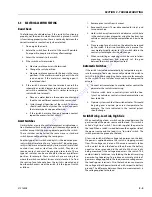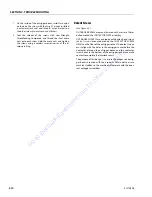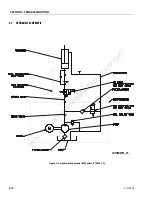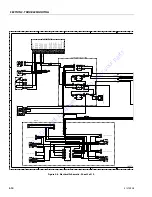
SECTION 3 - TROUBLESHOOTING
31215808
3-1
SECTION 3. TROUBLESHOOTING
3.1
GENERAL
This section contains troubleshooting information to be used
for locating and correcting most operating problems. If a
problem should develop which is not presented in this section
or which is not corrected by listed corrective actions, techni-
cally qualified guidance should be obtained before proceed-
ing with any maintenance.
3.2
TROUBLESHOOTING INFORMATION
Troubleshooting procedures applicable to this machine are
listed and defined starting with Table 3-1 and Table 3-2 in this
section of the manual.
Each malfunction within an individual group or system is fol-
lowed by a listing of probable causes which will enable deter-
mination of the applicable remedial action. The probable
causes and the remedial action should, where possible, be
checked in the order listed in the troubleshooting tables.
It should be noted that there is no substitute for a thorough
knowledge of the equipment and related systems.
It should be recognized that the majority of the problems aris-
ing in the machine will be centered in the hydraulic and elec-
trical systems. For this reason, every effort has been made to
ensure that all likely problems in these areas are given the full-
est possible treatment. In the remaining machine groups, only
those problems which are symptomatic of greater problems
which have more than one probable cause and remedy are
included. This means that problems for which the probable
cause and remedy may be immediately obvious are not listed
in this section.
The first rule for troubleshooting any circuit that is hydrauli-
cally operated and electrically controlled is to determine if the
circuit is lacking hydraulic oil and electrical control power. This
can be ascertained by overriding the bypass valve
(mechani-
cally or electrically)
so that oil is available to the function valve,
then overriding the function valve mechanically. If the func-
tion performs satisfactorily, the problem exists with the con-
trol circuit.
3.3
HYDRAULIC CIRCUIT CHECKS
The first reference for improper function of a hydraulic system,
where the cause is not immediately apparent, should be the
Hydraulic Diagram Circuit
.
The best place to begin the prob-
lem analysis is at the power source
(pump)
. Once it is deter-
mined that the pump is serviceable, then a systematic check of
the circuit components, would follow.
NOTE:
For aid in troubleshooting, refer to Figure 3-6. for HYDRAU-
LIC DIAGRAM circuit.
3.4
ELECTRICAL SYSTEM - MULTIMETER BASICS
A wide variety of multimeters or Volt Ohm Meters (VOM) can
be used for troubleshooting your equipment. A digital meter
with reasonable accuracy (within 7%) is recommended for the
measurements in these procedures. This section shows dia-
grams of a common, digital VOM configured for several differ-
ent circuit measurements. Instructions for your VOM may vary.
Please consult the meter operation manual for more informa-
tion.
Grounding
"Grounding the meter" means to take the black lead (which is
connected to the COM (common) or negative port) and touch
it to a good path to the negative side of the voltage source.
Backprobing
To "backprobe" means to take the measurement by accessing
a connector’s contact on the same side as the wires, the back
of the connector. Readings can be done while maintaining cir-
cuit continuity this way. If the connector is the sealed type,
great care must be taken to avoid damaging the seal around
the wire. It is best to use probes or probe tips specifically
designed for this technique, especially on sealed connectors.
Whenever possible insert probes into the side of the connec-
tor such that the test also checks both terminals of the con-
nection. It is possible to inspect a connection within a closed
connector by backprobing both sides of a connector terminal
and measuring resistance. Do this after giving each wire a gen-
tle pull to ensure the wires are still attached to the contact and
contacts are seated in the connector.
Min/Max
Use of the "Min/Max" recording feature of some meters can
help when taking measurements of intermittent conditions
while alone. For example, you can read the voltage applied to
a solenoid when it is only operational while a switch, far from
the solenoid and meter, is held down.
Go
to
Discount-Equipment.com
to
order
your
parts

































